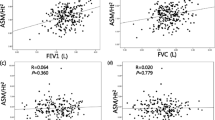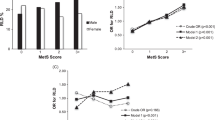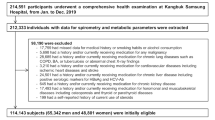Abstract
Background
Previous studies have indicated a relationship between type II diabetes (T2D), metabolic syndrome (MetS) and pulmonary function but the pathological mechanism responsible remains unclear. The aim of the current analysis within the Berlin Aging Study II (BASE-II) was to investigate the influence of abdominal obesity and muscle mass on pulmonary function in subjects with T2D and MetS.
Material and methods
A prebronchodilator pulmonary function test was carried out in 1369 subjects from the BASE-II (mean age 69 ± 4 years, 51.6 % women) where T2D was defined according to the German Diabetes Association (DDG) criteria, MetS according to the criteria of the International Diabetes Foundation (IDF), American Heart Association (AHA) and National Heart, Lung and Blood Institute (NHLBI) criteria from 2009 and pulmonary obstruction (obstructive lung disease, OLD) by the Global Initiative for Chronic Obstructive Lung Disease (GOLD) criteria of a forced expiratory volume in 1 s (FEV1 and forced vital capacity (FVC) ratio < 70 %.
Results
Of the subjects 50.9 % achieved a sufficient level of quality according to the GOLD guidelines and were analyzed with respect to the research question. The FEV1 and FVC were decreased in study participants with T2D and MetS and the lung volume decreased with an increasing number of MetS criteria. Parameters of body composition, such as waist circumference and muscle mass had a significant influence on lung volumes, independent of MetS or T2D.
Discussion
In this study MetS and T2D were associated with decreased lung volumes; however, muscle mass and abdominal obesity proved to be the most important factors influencing pulmonary function and could thus form the link between pulmonary function and MetS or T2D. Measurement of grip strength for the determination of muscle mass and waist circumference for determining abdominal obesity could contribute to the interpretation of the results of pulmonary function tests.

Similar content being viewed by others
References
Alberti KG, Eckel RH, Grundy SM et al (2009) Harmonizing the metabolic syndrome: a joint interim statement of the International Diabetes Federation Task Force on Epidemiology and Prevention; National Heart, Lung, and Blood Institute; American Heart Association; World Heart Federation; International Atherosclerosis Society; and International Association for the Study of Obesity. Circulation 120:1640–1645
Arcari A, Magnacca S, Bracone F et al (2013) Relation between pulmonary function and 10-year risk for cardiovascular disease among healthy men and women in Italy: the Moli-sani Project. Euro J Prev Cardiol 20:862–871
Bertram L, Böckenhoff A, Demuth I et al (2013) Cohort profile: the Berlin Aging Study II (BASE-II). Int J Epidemiol 43:702.712
Chen WL, Wang CC, Wu LW et al (2014) Relationship between lung function and metabolic syndrome. PLoS ONE 9:e108989
Cirillo DJ, Agrawal Y, Cassano PA (2002) Lipids and pulmonary function in the Third National Health and Nutrition Examination Survey. Am J Epidemiol 155:842–848
Costa D (2013) Pulmonary function after weight loss in obese women undergoing Roux-en-Y gastric bypass: one-year followup. ISRN Obesity 2013:796454
Eaton T, Withy S, Garrett JE et al (1999) Spirometry in primary care practice: the importance of quality assurance and the impact of spirometry workshops. Chest 116:416–423
Engstrom G, Hedblad B, Janzon L et al (2000) Respiratory decline in smokers and ex-smokers–an independent risk factor for cardiovascular disease and death. J Cardiovasc Risk 7:267–272
Engstrom G, Lind P, Hedblad B et al (2002) Lung function and cardiovascular risk: relationship with inflammation-sensitive plasma proteins. Circulation 106:2555–2560
Engstrom G, Wollmer P, Valind S et al (2001) Blood pressure increase between 55 and 68 years of age is inversely related to lung function: longitudinal results from the cohort study ‘Men born in 1914’. J Hypertens 19:1203–1208
Fadini GP, Losordo D, Dimmeler S (2012) Critical reevaluation of endothelial progenitor cell phenotypes for therapeutic and diagnostic use. Circ Res 110:624–637
Ferguson GT, Enright PL, Buist AS et al (2000) Office spirometry for lung health assessment in adultsa consensus statement from the National Lung Health Education Program. Chest 117:1146–1161
Ford ES, Cunningham TJ, Mercado CI (2014) Lung function and metabolic syndrome: Findings of National Health and Nutrition Examination Survey 2007–2010. J Diabetes 6:603–613
Geldmacher H, Biller H, Herbst A et al (2008) Die Prävalenz der chronisch obstruktiven Lungenerkrankung (COPD) in Deutschland. Dtsch Med Wochenschr 133:2609–2614
Glass DJ (2003) Molecular mechanisms modulating muscle mass. Trends Mol Med 9:344–350
Gudmundsson G, Gislason T, Lindberg E et al (2006) Mortality in COPD patients discharged from hospital: the role of treatment and co-morbidity. Respir Res 7:109
Hill K, Goldstein RS, Guyatt GH et al (2010) Prevalence and underdiagnosis of chronic obstructive pulmonary disease among patients at risk in primary care. CMAJ 182:673–678
Inomata M, Kawagishi Y, Taka C et al (2012) Visceral adipose tissue level, as estimated by the bioimpedance analysis method, is associated with impaired lung function. J Diabetes Investig 3:331–336
Irfan M, Jabbar A, Haque AS et al (2011) Pulmonary functions in patients with diabetes mellitus. Lung India 28:89–92
Jacobs DR Jr, Muldoon MF, Rastam L (1995) Invited commentary: low blood cholesterol, nonillness mortality, and other nonatherosclerotic disease mortality: a search for causes and confounders. Am J Epidemiol 141:518–522
Jialal I, Fadini GP, Pollock K et al (2010) Circulating levels of endothelial progenitor cell mobilizing factors in the metabolic syndrome. Am J Cardiol 106:1606–1608
Jiang R, Burke GL, Enright PL et al (2008) Inflammatory markers and longitudinal lung function decline in the elderly. Am J Epidemiol 168:602–610
Kannel WB, Hubert H, Lew EA (1983) Vital capacity as a predictor of cardiovascular disease: the Framingham study. Am Heart J 105:311–315
Kellerer M, Siegel E (2013) Praxisempfehlungen der Deutschen Diabetes Gesellschaft. Diabetologie 8(Suppl 2):S103
Klein O, Krishnan J, Glick S et al (2010) Systematic review of the association between lung function and type 2 diabetes mellitus. Diabet Med 27:977–987
Klein OL, Kalhan R, Williams MV et al (2012) Lung spirometry parameters and diffusion capacity are decreased in patients with type 2 diabetes. Diabet Med 29:212–219
Kuliszewski MA, Ward MR, Kowalewski JW et al (2013) A direct comparison of endothelial progenitor cell dysfunction in rat metabolic syndrome and diabetes. Atherosclerosis 226:58–66
Leone N, Courbon D, Thomas F et al (2009) Lung function impairment and metabolic syndrome: the critical role of abdominal obesity. Am J Respir Crit Care Med 179:509–516
Lin CC, Chang CT, Li TC et al (2002) Objective evidence of impairment of alveolar integrity in patients with non-insulin-dependent diabetes mellitus using radionuclide inhalation lung scan. Lung 180:181–186
Mancuso P (2010) Obesity and lung inflammation. J Appl Physiol 108:722–728
Mcneill AM, Rosamond WD, Girman CJ et al (2005) The metabolic syndrome and 11-year risk of incident cardiovascular disease in the atherosclerosis risk in communities study. Diabetes Care 28:385–390
Minas M, Kostikas K, Papaioannou AI et al (2011) The association of metabolic syndrome with adipose tissue hormones and insulin resistance in patients with COPD without co-morbidities. COPD 8:414–420
Moebus S, Hanisch J, Bramlage P et al (2008) Regional differences in the prevalence of the metabolic syndrome in primary care practices in Germany. Dtsch Arztebl Int 105:207–213
Quanjer P, Tammeling G, Cotes J et al (1993) Lung volumes and forced ventilatory flows. Report Working Party Standardization of Lung Function Tests, European Community for Steel and Coal. Official Statement of the European Respiratory Society. Eur Respir J 6(Suppl 16):5–40
Quanjer PH, Stanojevic S, Cole TJ (2012) Multi-ethnic reference values for spirometry for the 3–95-yr age range: the global lung function 2012 equations. Eur Respir J 40:1324–1343
Rabe KF, Hurd S, Anzueto A et al (2007) Global strategy for the diagnosis, management, and prevention of chronic obstructive pulmonary disease: GOLD executive summary. Am J Respir Crit Care Med 176:532–555
Rachas A, Raffaitin C, Barberger-Gateau P et al (2012) Clinical usefulness of the metabolic syndrome for the risk of coronary heart disease does not exceed the sum of its individual components in older men and women. The Three-City (3C) Study. Heart 98:650–655
Rana JS, Mittleman MA, Sheikh J et al (2004) Chronic obstructive pulmonary disease, asthma, and risk of type 2 diabetes in women. Diabetes Care 27:2478–2484
Rathmann W, Haastert B, Icks AA et al (2003) High prevalence of undiagnosed diabetes mellitus in Southern Germany: target populations for efficient screening. The KORA survey 2000. Diabetologia 46:182–189
Salome CM, King GG, Berend N (2010) Physiology of obesity and effects on lung function. J Appl Physiol 108:206–211
Scarlata S, Fimognari FL, Cesari M et al (2013) Lung function changes in older people with metabolic syndrome and diabetes. Geriatr Gerontol Int 13:894–900
Schols AM, Broekhuizen R, Weling-Scheepers CA et al (2005) Body composition and mortality in chronic obstructive pulmonary disease. Am J Clin Nutr 82:53–59
Serres I, Gautier VR, PréFaut C et al (1998) Impaired skeletal muscle endurance related to physical inactivity and altered lung function in copd patients. Chest 113:900–905
Seshasai S, Kaptoge S, Thompson A et al (2011) Diabetes mellitus, fasting glucose, and risk of cause-specific death. N Engl J Med 364:829
Sin DD, Wu L, Man SFP (2005) The relationship between reduced lung function and cardiovascular mortality: a population-based study and a systematic review of the literature. Chest 127:1952–1959
Song Y, Klevak A, Manson JE et al. (2010) Asthma, chronic obstructive pulmonary disease, and type 2 diabetes in the Women’s Health Study. Diabetes Res Clin Pract 90:365–371
Sumner AD, Khalil YK, Reed JF (2012) The relationship of peripheral arterial disease and metabolic syndrome prevalence in asymptomatic US adults 40 years and older: results from the National Health and Nutrition Examination Survey (1999–2004). J Clin Hypertens 14:144–148
Szanto O, Montnemery P, Elmstahl S (2010) Prevalence of airway obstruction in the elderly: results from a cross-sectional spirometric study of nine age cohorts between the ages of 60 and 93 years. Prim Care Respir J 19:231–236
Thijs W, Dehnavi RA, Hiemstra PS et al (2014) Association of lung function measurements and visceral fat in men with metabolic syndrome. Respir Med 108:351–357
Vogelmeier C, Buhl R, Criee CP et al (2007) [Guidelines for the diagnosis and therapy of COPD issued by Deutsche Atemwegsliga and Deutsche Gesellschaft fur Pneumologie und Beatmungsmedizin]. Pneumologie 61:e1–40
Watz H, Waschki B, Kirsten A et al (2009) The metabolic syndrome in patients with chronic bronchitis and COPD: frequency and associated consequences for systemic inflammation and physical inactivity. Chest 136:1039–1046
Wilson PF, D’agostino RB, Sullivan L et al (2002) Overweight and obesity as determinants of cardiovascular risk: the Framingham experience. Arch Intern Med 162:1867–1872
Yeh F, Dixon AE, Marion S et al (2011) Obesity in adults is associated with reduced lung function in metabolic syndrome and diabetes: the Strong Heart Study. Diabetes Care 34:2306–2313
Author information
Authors and Affiliations
Corresponding author
Ethics declarations
Conflict of interest
N. Buchmann, K. Norman, E. Steinhagen-Thiessen, I. Demuth, and R. Eckardt declare that there are no conflicts of interest.
All procedures followed were in accordance with the ethical standards of the responsible committee on human experimentation (institutional and national) and with the Helsinki Declaration of 1975 (in its most recently amended version). Informed consent was obtained from all patients included in the study.
Additional information
There exists a German version of this article under DOI 10.1007/s00391-015-0959-z
Rights and permissions
About this article
Cite this article
Buchmann, N., Norman, K., Steinhagen-Thiessen, E. et al. Lung function in elderly subjects with metabolic syndrome and type II diabetes. Z Gerontol Geriat (2015). https://doi.org/10.1007/s00391-015-0958-0
Received:
Accepted:
Published:
DOI: https://doi.org/10.1007/s00391-015-0958-0




